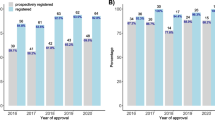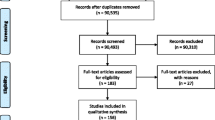Abstract
Introduction
To safeguard the safety and interests of subjects participating in clinical trials, their conduct is heavily regulated. The EU Clinical Trials Regulation (CTR) 536/2014 brings fundamental changes that will require sponsors to adapt their current way of working. One major change is the significant shortening of the permitted reply timelines to requests for information (RFI), which may require adaptations to established processes within an organisation. This study aimed to assess these reply timelines at the European Organisation for Research and Treatment of Cancer (EORTC), a non-commercial sponsor. Additionally, it aimed to investigate how the impact of the different CTR requirements is perceived by the organisation’s staff.
Methods
A retrospective analysis was performed to assess the length of reply to grounds of non-acceptance (GNA) timelines. Questionnaires were circulated to internal staff to assess their views on the impact of important changes the CTR introduces on the organisation’s processes.
Results
The average reply time to comments from regulators was 27.5 days, which is longer than the 12-day time limit required by CTR, which indicates that the organisation’s processes require re-optimization to allow efficient activation of trials compliant with the new legislation. The majority of the staff that completed the questionnaire assessed the impact the CTR would have on the organisation to be positive. Finally, there was a large consensus about the changes related to the submission timelines, transition period and the user management of the Clinical Trial Information System (CTIS) having a very important impact on the organisation as a whole. Participants referred to the streamlined process of a clinical trial in different countries as foreseen in the CTR, as an aspect that would benefit the organisation.
Discussion
For all retrospectively studied timelines, the average timelines to reply combined for competent authorities (CA) and ethics committees (EC) were longer than the 12 days allowed under the CTR. EORTC will have to adapt internal processes to meet the time limit imposed by the CTR without compromising its scientific integrity. The questionnaire respondents had the required expertise to provide an opinion on the CTR’s impact on the organisation. There was a large consensus about the changes relating to the submission timelines having a very important impact on the organisation. This observation is in line with the results of the retrospective part of this study.
Conclusion
Based on the results of the retrospective and prospective parts of the study, it is clear that the shorter reply timelines are the main factor that will affect the organisation. EORTC has spent significant resources in adapting its processes to comply with the CTR’s new requirements. Experience with the first studies under the new regulation can be utilized to implement further process adaptations.


Similar content being viewed by others
References
Directive 2001/20/EC of the European Parliament and of the Council of 4 April 2001 on the Approximation of the Laws, Regulations and Administrative Provisions of the Member States Relating to the Implementation of Good Clinical Practice in the Conduct of Clinical Trials on Medicinal Products for Human Use (OJ L 121, 1.5.2001, p. 34).
van Doorn E, Hak E, Wilffert B. National differences in requirements for ethical and competent authority approval for a multinational vaccine trial under the EU Directive 2001/20/EC. Vaccines. 2015;3(2):263–92.
Regulation (EU) No 536/2014 of the European Parliament and of the Council of 16 April 2014 on Clinical Trials on Medicinal Products for Human Use, and Repealing Directive 2001/20/EC.
Gefenas E, Cekanauskaite A, Lekstutiene J, Lukaseviciene V. Application challenges of the new EU Clinical Trials Regulation. Eur J Clin Pharmacol. 2017;73(7):795–8.
Scavone C, di Mauro G, Pietropaolo M, Alfano R, Berrino L, Rossi F, Tomino C, Capuano A. The European clinical trials regulation (No 536/2014): changes and challenges. Expert Rev Clin Pharmacol. 2019;12(11):1027–32.
Atzor S, Gokhale S, Doherty M. Will the EU clinical trials regulation support the innovative industry in bringing new medicines faster to patients? Pharmaceut Med. 2013;27(2):75–82.
Ostuzzi G, Gastaldon C, Petrini C, Godman B, Barbui C. Poor implementation of the EU clinical trial regulation is a major threat for pragmatic trials in European countries. Epidemiol Psychiatr Sci. 2020;29:e126.
Chase D, Roder B, Romero MI. Klinische Prüfung von Arzneimitteln—erste Erfahrungen mit der neuen EU-Verordnung 536/2014, Herausforderungen und Chancen für Auftragsforschungsinstitute. Bundesgesundheitsblatt Gesundheitsforschung Gesundheitsschutz. 2023;66(1):21–7.
Acknowledgements
This work was supported by Kom op tegen Kanker (Stand up to Cancer), the Flemish cancer society from Belgium and by the EORTC Cancer Research Fund (ECRF).
Funding
No specific funding was available for this study.
Author information
Authors and Affiliations
Contributions
JS made substantial contributions to the conception and design of the work; the acquisition, analysis, to interpretation of data for the work and drafting the work. SV made substantial contributions to the acquisition and analysis of data for the work; and revising the work critically for important intellectual content. SK made substantial contributions to the conception and design of the work; the acquisition and interpretation of data for the work and revising the work critically for important intellectual content. AD made substantial contributions to the conception and design of the work; the interpretation of data for the work and revising the work critically for important intellectual content.
Corresponding author
Ethics declarations
Conflict of interest
The authors declare no conflict of interest.
Additional information
Publisher's Note
Springer Nature remains neutral with regard to jurisdictional claims in published maps and institutional affiliations.
Supplementary Information
Below is the link to the electronic supplementary material.
Rights and permissions
Springer Nature or its licensor (e.g. a society or other partner) holds exclusive rights to this article under a publishing agreement with the author(s) or other rightsholder(s); author self-archiving of the accepted manuscript version of this article is solely governed by the terms of such publishing agreement and applicable law.
About this article
Cite this article
Stans, J., Verbandt, S., Kromar, S. et al. Implementation of Regulation (EU) No 536/2014 as a Non-commercial Sponsor: An Internal Survey and a Descriptive Analysis of Timelines. Ther Innov Regul Sci 57, 1113–1120 (2023). https://doi.org/10.1007/s43441-023-00553-x
Received:
Accepted:
Published:
Issue Date:
DOI: https://doi.org/10.1007/s43441-023-00553-x




